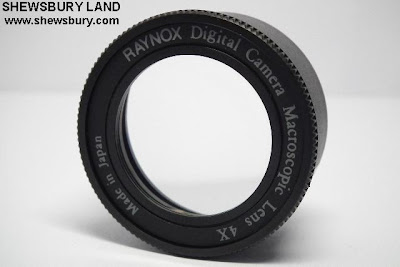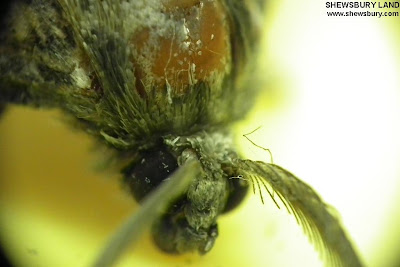Raynox MSN-202 Macro Lens

This is the review of Raynox MSN-202 Macro Lens (or rather macro conversion lens) made by Raynox Japan and we get it from McGill Singapore for SGD 155.00 (about USD 120 / 9,720 yen)
First and foremost, it is important for me to say that this lens in a way is ideal for Panasonic Lumix DMC-LX3. That is the very reason why we bought this lens in the first place. However, other camera/lens model are also compatible though the result might varies in accordance to the camera/lens specification as well as the user skills in handling it.
The box;

Out of the box, you will get all these stuff...

The user manual in Japanese and English...

And the lens from this plastic box...

This is it now the universal adapter and the MSN-202 lens...

The Universal Adapter UAC 3500...

Can fit any lens with the size of 52mm to 67mm...


The MSN-202 Macro Conversion Lens.



The Raynox DCR-250 Macro Lens can give 8 diopters while this Raynox MSN-202 can give 25 diopters - that is 3 times more magnification than the DCR-250.

The specification of this lens is as below;
Magnification: 25-Diopter
Lens construction: 3G/4E Optical coated glass elements
Image size: 1.9mm width
Effective zooming without vignetting: 12x - 20x zoom
Front filter size: None
Mounting threads: 37mm
Size/Weight: 22 x 42mm/60g(2.1oz)
Accessories included: Lens caps, Lens case, Universal adapter UAC3500.


Attaching the MSN-202 onto the UAC 3500...


And after that just attached the set to the front of the camera lens...

As I mentioned earlier, our LX3 is the main reason why we bought this MSN-202.

To use this MSN-202 with your LX3, you must have that lens adapter tube which you can buy from E-Bay or any other online shop accordingly.

"Luckily" I managed to find someone who "volunteer" to be our "test subject" - Ladies and gents, let me introduce to you our model for today - this cute little butterfly - or so I thought;
UPDATED 29 October 2010 : Apparently this is not butterfly, it's a "Moth", thanks and credits to my friend BMecha for the correct name. Finally now I knew the name....

Now these are some sample shots take with Panasonic LX3;



It's amazing to see those feathers on this insect.... details, lot's of details....


And we also have some samples using our reliable super zoom, the Fujifilm HS10;



The long zoom of the Fujifilm HS10 certainly helpful to capture more details....







I still need to test this lens on "real life situation" - that is in the park. I need to try to captured a fly and maybe also those little spiders.... more testing need to be done before I can grab the full potential of this lens but for now, I think it is quite a good lens with 3 times more magnification power if compared to the Raynox DCR-250 Macro Lens.
1 important thing to highlight is that the focusing distance. The Raynox DCR-250 Macro Lens, the focusing distance is about 10-11cm (about 4 inches and sometime between 4 to 6 inches depending on the insect's size). This Raynox MSN-202 Macro Lens however have a very close focusing distance, about 3-5cm (basically within 2 inches) and that is quite though. You really need to do lots of practice to get used to it and capturing a photo of an active fly can be daunting.
I will give it a try this weekend and hopefully if I managed to get some result, I will upload the photos by next week.
Overall, this MSN-202 Macro Conversion Lens is a very nice accessories but it is also quite challenging to use if compared to the more popular Raynox DCR-250 Macro Lens. This lens is useful especially for those who owned Panasonic LX3 and also only if you like the wonderful world of macro photography. This is not something that I can recommend for casual photographer who only interested with the normal portrait/people photography as well as scenery photography. This type of lens is really for a special purpose and for certain type of photographer only - not for everybody.
And for those who interested with macro and wish to buy either this Raynox MSN-202 or Raynox DCR-250, you can get them either from E-Bay or from Shewsbury Land favorite online shop for camera accessories - McGill Singapore.
Or alternately, you can visit the link below;
http://www.mcgill.com.sg/shop/product_info.php?products_id=148&osCsid=a12e2cdddca1d864a7182030500a533b
http://www.mcgill.com.sg/shop/product_info.php?products_id=101&osCsid=24782daa60137bcad24554adb6174499
UPDATED : November 2, 2010 - Finally this is now some additional sample photos using Panasonic LX3 and Raynox MSN-202







end


Wow nice quality pictures!
ReplyDeleteBro, that's a moth, not butterfly :P
ReplyDeleteInstead of temp me with the LX-3 lens, I have higher interest for DSLR now. Telephoto lens + close up >.< amazing details.
As you said, real battle in nature (park) is something totally different from static objects. Zoom is a must and LX-3 just not good enough to get the job done :(
Bmecha, thanks a lot for the name - seriously for many years now I never knew the name and blindly assume it's a butterfly or some sort. So the name is MOTH, OK will remember that.
ReplyDeleteAs for the real test in the park with real fly, I can predict that it will be difficult but somehow I will give it a try using both the LX3 and the long zoom Fujifilm HS10.
As for DSLR, well obviously that is the best monster of photography and no other compact digicam can match them. You get what you pay. I'm the type who like to experiments different brand of camera and it is possible that I go back to DSLR again in the future.